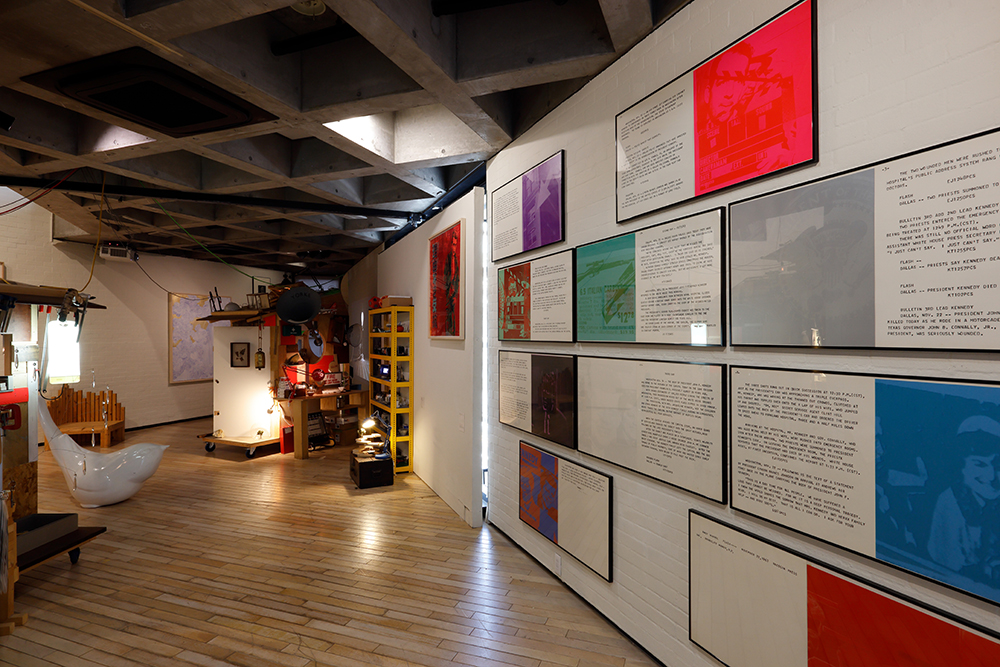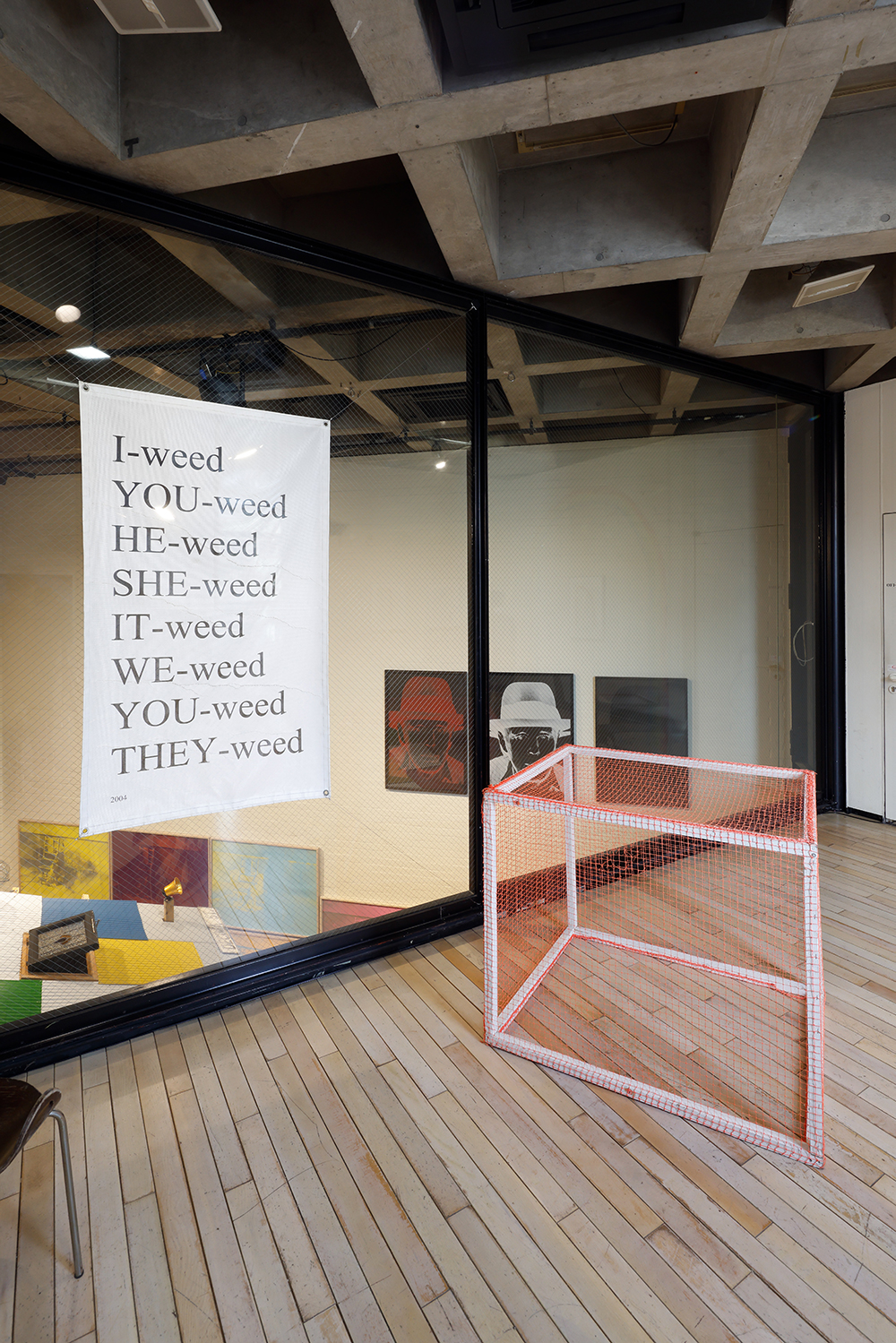EXHIBITION
I want to be ART
Art may be about perfect camouflage.
In the exhibition Perfect Camouflage, 11 artists from the WATARI-UM collection including Andy Warhol, and guest artists Hiraki Sawa, Noguchi Rika, and Hiroshi Sugito, will exhibit approximately 80 works. The exhibition is divided into four chapters: Camouflage into Everyday Life, Camouflage into Nature, Camouflage into Memory, and Camouflage into Space.
"The reason I'm painting this way is that I want to be a machine." -Andy Warhol
From the interview in ARTnews in November 1963. Since 1960, Warhol used to create lots of silkscreen works. Using the same plate, he created unique images by changing colors, intentionally shifting the prints, and making the ink run off.
"What is beyond plants is at one with them" -Lois Weinberger
This is the title of his work exhibited at Documenta X in 1997. Weinberger removed herbicide and planted ruderal plants on the old track of Kassel central station to transform it into a garden. He likened the plants taking roots in German soil to immigrants.
Camouflage is the act of hiding one's presence and blending into one's surroundings.
The situation around us gives birth to us, and then another situation is created. History is repetition of this.
Camouflage is a survival instinct. When we are drowned by so many things, objects and minds, on the streets, in nature, all day long, all over the world, we camouflage ourselves into our everyday lives to hide.
What you camouflage yourself in is up to you.
Becoming an object
Nishida Kitaro
Nishida Kitaro: I think science has to get to the essence of objects. ...I think the more it can leave the human being and become an object itself, the better. ...To leave means to leave one's own subjectivity. It's not about leaving science. ...
D. T. Suzuki: In the Western way, to leave means to separate. It is not entering into an object. To enter is the Eastern way.
Nishida Kitaro: I don't think there is such a way of thinking in the West; to become an object.
February 28, 1941 From the audio recording of the conversation between Nishida Kitaro, D. T. Suzuki and Yamamoto Ryokichi
Collection: Ishikawa NISHIDA KITARO Museum of Philosophy
* The audio recording of the conversation between Nishida Kitaro, D. T. Suzuki and Yamamoto Ryokichi (collection: Ishikawa NISHIDA KITARO Museum of Philosophy) will be played in the exhibition space.
WORKS
Chapter 1: Camouflage into Everyday Life
Chapter 2: Camouflage into Nature
Chapter 3: Camouflage into Memory
Chapter 4: Camouflage into Space
PROFILE
-
Andy Warhol
1928-1987 U.S.
Began creating Pop Art works while working as a commercial illustrator in the 1950s. He gained overwhelming popularity for his works depicting icons of popular culture such as Marilyn Monroe and soup cans. Since the 1970s he has become a social figure due to his popularity and scandals.
-
Man Ray
1890-1976 U.S.
Played an active role in various realms such as painting, object, photography, and film as the leading figure of Dada, Surrealism, and Avant-garde art movement in the 1910s. He also invented photographic expressions such as solarization and shooting without cameras using rayograph by placing objects on printing paper, and established photography as a new artistic expression.
-
Hiraki Sawa
1977- Japan
Creates dreamy film works by introducing images that supposed to exist in everyday space, such as a large number of airplanes flying inside a room. In recent years, he has expanded his production to include installations that combine film and music.
-
Lois Weinberger
1947-2020 Austria
Began working with natural and man-made spaces in the 1970s. In 1988, he began a garden project in which he planted ruderal plants grown in his garden in Vienna. He has been influential in the discussion of nature and art since the 1990s.
-
Gary Hill
1951- U.S.
He came into the limelight at Documenta 9 in 1992 and has been overwhelmingly supported as an important video artist after Nam June Paik. His work is sharply rendered with dreamlike, ephemeral and ambiguous images.
-
Noguchi Rika
1971- Japan
A unique perspective that moves between the microscopic and the macroscopic. Her choice of subjects touches on the mysteries of human nature. Known both in Japan and abroad for her transparent colors and poetic photographic works, she is not limited to the world of photography, but participates in a number of international exhibitions of contemporary art.
-
Christian Boltansky
1944-2021 France
Began presenting works using photography and light bulbs or light since the late 1970s. Since 1984, he began the Monument series, which is reminiscent of altars. The figures in the photographs are Jewish children persecuted by the Nazis.
-
Joseph Beuys
1921-1986 Germany
He arrived at the concept of "social sculpture," which extended the concepts of sculpture and art to education and social change, and engaged in political activities aimed at building a normal relationship between society and art. He was one of the founders of the Green Party.
-
Hiroshi Sugito
1970- Japan
He likes to paint simple motifs such as small houses, the sky, and boats, and his works are characterized by delicately and rhythmically arranged colors and shapes. In recent years, he has been going beyond the framework of painting to create new exhibition spaces where architecture and his works interact with each other.
-
Donald Judd
1928-1994, U.S.
He called his works neither paintings nor sculptures, but "specific objects". He exhibited his works in a number of exhibitions around the world and also participated as an art critic.
-
Max Bill
1908-1994 Switzerland
He was active in the fields of architecture, painting, sculpture, writing, education, and politics. He was Acknowledged as one of the "last Bauhaus masters" and his logic moulding was based on the idea of mathematic concepts.
-
Nam June Paik
1932-2006 Korea / U.S.
Joined Fluxus in the early 1960s. He moved to New York in 1964 and created media art using video images and electronic music. The collaboration of technology and Eastern Thought is seen in his works.
-
Lin Tian Miao
1962- China
Moved to New York in 1988, and since then has based her activity in Beijing and New York. She has held solo exhibitions such as “Open Studio. Baofang Hutong 12#” (Beijing 1995). She has been appealing various issues contemporary China carries which is difficult to convey through words.
-
Keith Haring
1958-1990 U.S.
Appeared from East Village in the beginning of the 1980s, and immediately became a pioneer of graffiti art known internationally. He brought art outside of galleries and museums through production on subways and in the streets.
SCENE
-

photo by: Keizo Kioku
-

photo by: Keizo Kioku
-

photo by: Keizo Kioku
-

photo by: Keizo Kioku
-

photo by: Keizo Kioku
-

photo by: Keizo Kioku
-

photo by: Keizo Kioku
-

photo by: Keizo Kioku
-

photo by: Keizo Kioku
-

photo by: Keizo Kioku
-

photo by: Keizo Kioku















